For the 2025 school year, there is 1 public middle school serving 175 students in Gfw School District.
Public Middle Schools in Gfw School District have a diversity score of 0.35, which is less than the Minnesota public middle school average of 0.59.
Minority enrollment is 22% of the student body (majority Hispanic), which is less than the Minnesota public middle school average of 38% (majority Black and Hispanic).
Overview
This School District
This State (MN)
# Schools
3 Schools
1,003 Schools
# Students
611 Students
272,988 Students
# Teachers
47 Teachers
17,811 Teachers
Student : Teacher Ratio
13:1
13:1
District Rank
Gfw School District, which is ranked within the bottom 50% of all 522 school districts in Minnesota (based off of combined math and reading proficiency testing data) for the 2021-2022 school year.
The school district's graduation rate of 80-89% has decreased from 90-94% over five school years.
Overall District Rank
#312 out of 527 school districts
(Bottom 50%)
(Bottom 50%)
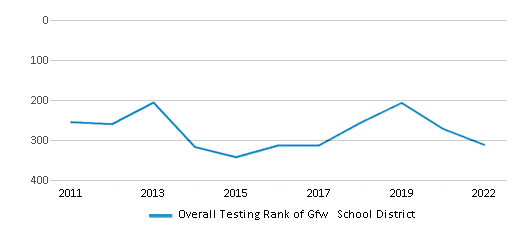
Math Test Scores (% Proficient)
34%
45%
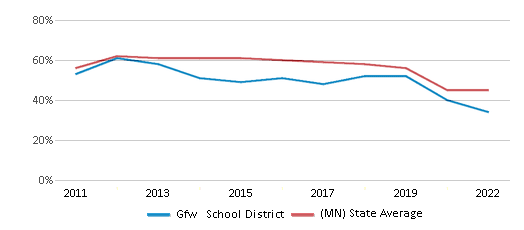
Reading/Language Arts Test Scores (% Proficient)
47%
51%
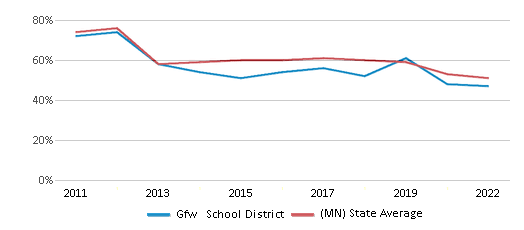
Science Test Scores (% Proficient)
34%
41%
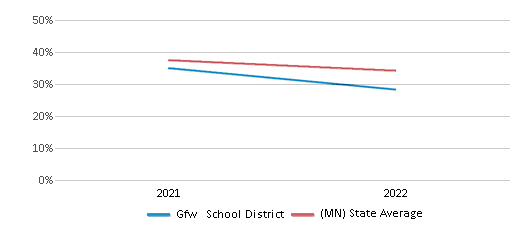
Graduation Rate
80-89%
84%
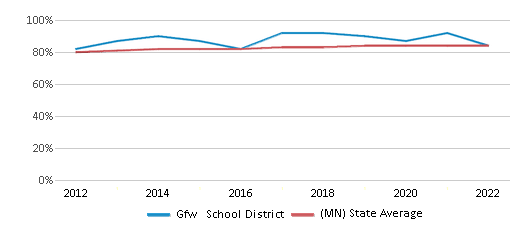
Students by Ethnicity:
Diversity Score
0.40
0.59
# American Indian Students
1 Student
6,086 Students
% American Indian Students
n/a
2%
# Asian Students
4 Students
17,993 Students
% Asian Students
1%
7%
# Hispanic Students
129 Students
30,064 Students
% Hispanic Students
21%
11%
# Black Students
3 Students
32,798 Students
% Black Students
n/a
12%
# White Students
456 Students
169,010 Students
% White Students
75%
62%
# Hawaiian Students
n/a
306 Students
% Hawaiian Students
n/a
n/a
# Two or more races Students
18 Students
16,731 Students
% of Two or more races Students
3%
6%
Students by Grade:
# Students in PK Grade:
15
847
# Students in K Grade:
40
2,545
# Students in 1st Grade:
43
2,825
# Students in 2nd Grade:
32
2,938
# Students in 3rd Grade:
36
2,965
# Students in 4th Grade:
45
3,207
# Students in 5th Grade:
36
11,547
# Students in 6th Grade:
40
53,234
# Students in 7th Grade:
44
63,243
# Students in 8th Grade:
55
64,723
# Students in 9th Grade:
56
14,851
# Students in 10th Grade:
57
15,978
# Students in 11th Grade:
53
16,184
# Students in 12th Grade:
59
17,901
# Ungraded Students:
-
-
District Revenue and Spending
The revenue/student of $18,872 is higher than the state median of $17,854. The school district revenue/student has grown by 9% over four school years.
The school district's spending/student of $17,484 is less than the state median of $18,580. The school district spending/student has grown by 9% over four school years.
Total Revenue
$12 MM
$15,547 MM
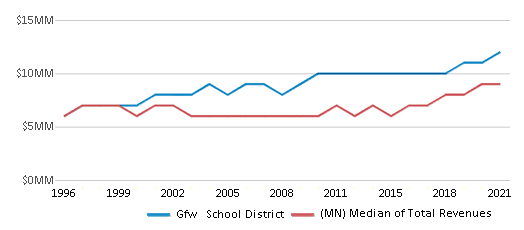
Spending
$11 MM
$16,179 MM

Revenue / Student
$18,872
$17,854
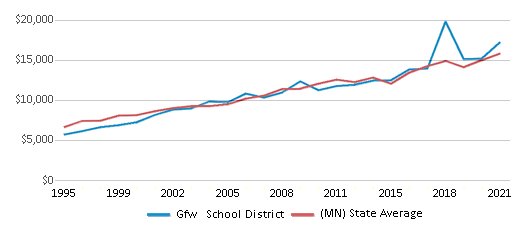
Spending / Student
$17,484
$18,580

Best Gfw School District Public Middle Schools (2025)
School
(Math and Reading Proficiency)
(Math and Reading Proficiency)
Location
Grades
Students
Rank: n/an/a
1001 N Cottonwood St
Winthrop, MN 55396
(507) 647-5382
Winthrop, MN 55396
(507) 647-5382
Grades: 5-8
| 175 students
Recent Articles

Year-Round Or Traditional Schedule?
Which is more appropriate for your child? A year-round attendance schedule or traditional schedule? We look at the pros and cons.

Why You Should Encourage Your Child to Join a Sports Team
Participating in team sports has a great many benefits for children, there is no doubt. In this article you will learn what those benefits are.

White Students are Now the Minority in U.S. Public Schools
Increasing birth rates among immigrant families from Asia and Central and South America, combined with lower birth rates among white families, means that for the first time in history, public school students in the United States are majority-minority. This shift in demographics poses difficulties for schools as they work to accommodate children of varying language abilities and socio-economic backgrounds.





